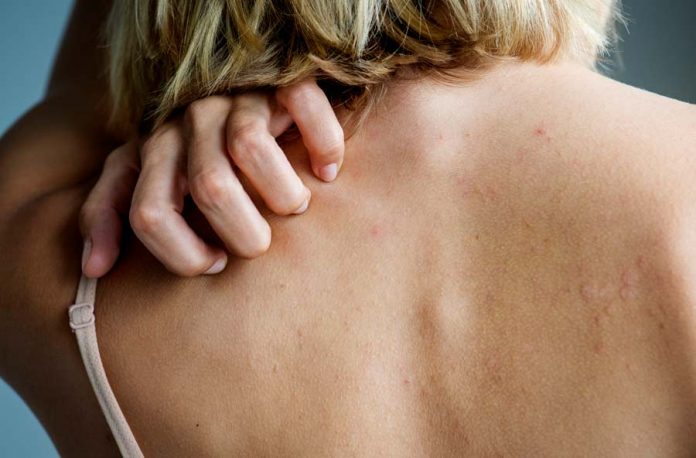Skin disorders, such as acne and eczema, vary greatly in symptoms and severity. They can be temporary or permanent and may be painless or painful. Some can be life threatening.
List of skin disorders
Acne
Acne is commonly on the face, neck, shoulders, chest, and upper back.
Breakouts on the skin are composed of redness, blackheads, whiteheads, pimples, or deep, painful cysts and nodules.
This condition may leave scars or darken the skin if untreated.
People of Color can experience dark spots known as post-inflammatory hyperpigmentation (PIH).
Pictures of different skin disorders
There are many different types of skin disorders. Here are pictures of 25 different conditions, followed by a list of details for each
Cold sore
This condition causes a red, painful, fluid-filled blister that appears near the mouth and lips. People with lighter skin may notice more redness than those with darker skin.
The affected area will often tingle or burn before the sore is visible.
Outbreaks may also be accompanied by mild, flu-like symptoms such as low fever, body aches, and swollen lymph nodes.
Cold sores usually look similar on any skin color but can also cause PIH in people with darker skin.
Learn more about cold sores and cold sores on dark skin
Blister
Blisters are characterized by a watery, clear, fluid-filled area on the skin.
They may be smaller than 1 centimeter (cm) (vesicle) or larger than 1 cm (bulla) and can occur alone or in groups.
Blisters can be found anywhere on the body
Hives
This causes itchy, raised welts that occur after exposure to an allergen.
Welts may be warm and mildly painful to the touch.
Hives on darker skin can appear raised or inflamed and might be slightly darker or lighter than your natural skin color. On lighter skin, hives usually appear red.
They can be small, round, ring-shaped, or randomly shaped.
Actinic keratosis
This condition causes a thick, scaly, or crusty skin patch.
It’s typically less than 2 or about the size of a pencil eraser.
It often appears on parts of the body that receive a lot of sun exposure, such as the hands, arms, face, scalp, and neck.
The skin patch is usually pink in color but can have a brown, tan, or gray base. This patch may appear the same color as the surrounding skin in people with darker skin.
Rosacea
This chronic skin disease goes through cycles of fading and relapse.
Relapses may be triggered by spicy foods, alcoholic beverages, sunlight, stress, and the intestinal bacteria Helicobacter pylori.
There are four subtypes of rosacea encompassing a wide variety of symptoms.
Common symptoms include facial flushing, raised red bumps, skin dryness, and skin sensitivity.
People with darker skin tones may notice brown discoloration or dry and swollen patches of dark skin.
Carbuncle
This causes a red, painful, and irritated lump under your skin.
It may be by fever, body aches, and fatigue.
It can also cause skin crustiness or oozing.
It may appear more violet on darker skin.
Latex allergy
This condition is considered a medical emergency. Urgent care may be required. Contact 911 or local emergency services.
This causes a rash, which may occur within minutes to hours after exposure to a latex product. It may be less visible on darker skin or appear lighter or darker than surrounding tissue.
It also causes warm, itchy wheals at the site of contact, which may take on a dry, crusted appearance with repeated exposure to latex.
Airborne latex particles may cause cough, runny nose, sneezing, and itchy, watery eyes.
A severe allergy to latex can cause swelling and difficulty breathing.
Eczema
Eczema is characterized by pink, red, brown, purple, or gray, sometimes with scaly patches that flake off.
Affected areas may be itchy, greasy, or oily.
On light skin, eczema can cause a red rash. This rash may appear brown, purple, or gray on darker skin.
Hair loss may also occur in the area with the rash.
Psoriasis
This causes scaly, silvery, sharply defined skin plaques. Darker-skinned people might also experience dark brown or purplish patches on the skin.
Patches are commonly located on the scalp, elbows, knees, and lower back.
This condition may be itchy or asymptomatic.
Cellulitis
Cellulitis is a medical emergency. A person should contact 911 or local emergency services if they have any symptoms of cellulitis.
Cellulitis is caused by bacteria or fungi through a crack or cut in the skin.
It causes painful swollen skin with or without oozing that spreads quickly.
The skin might appear red on lighter skin. However, this may be less noticeable on darker skin tones.
The skin may feel hot and tender to the touch.
Fever, chills, and red streaking from the rash might be symptoms of a serious infection requiring medical attention.
Measles
Symptoms of measles include fever, sore throat, red or watery eyes, loss of appetite, cough, and runny nose.
It also causes a red rash, which spreads from the face down the body 3-5 Source after the first symptoms appear. This rash might be more difficult to see on darker skin.
Tiny red spots with blue-white centers may appear inside the mouth.
Measles may Source more obvious PIH in People of Color
Basal cell carcinoma
It can cause dome-like, pink or red, shiny, and pearly areas that may have a sunk-in center, like a crater. For people with dark skin, it might appear darker and less pearly.
This condition is often characterized by raised, firm, and pale areas that may Source a scar.
Blood vessels on the growth may be visible.
It might cause easy bleeding or an oozing wound that doesn’t seem to heal, or it heals and then reappears.
Squamous cell carcinoma
This condition often Source in areas exposed to ultraviolet (UV) radiation, such as the face, ears, and back of the hands.
It may be characterized by a scaly, reddish patch of skin, which progresses to a raised bump that continues to grow. The bump may be lighter on darker skin.
It can also cause a growth that bleeds easily, doesn’t heal, or heals and then reappears.
Melanoma
It can appear anywhere on the body as a mole that has irregularly shaped edges, asymmetrical shapes, and multiple colors. In People of Color, melanoma often appears in areas that are less exposed to the sun.
It might also appear as a mole that has changed color or gotten bigger over time, which is usually larger than a pencil eraser.
What are lifelong skin conditions?
Some chronic skin conditions present from birth, while others appear suddenly later.
The cause of these disorders isn’t always known. Many permanent skin disorders have effective treatments that enable extended periods of remission. However, they’re incurable, and symptoms can reappear at any time.
Examples of chronic skin conditions include:
rosacea, which is characterized by small, pus-filled bumps on the face
psoriasis, which causes scaly, itchy, and dry plaques
vitiligo, which results in large, irregular patches of lighter skin
eczema, which causes itchy, red, dry, and irritated skin.


























